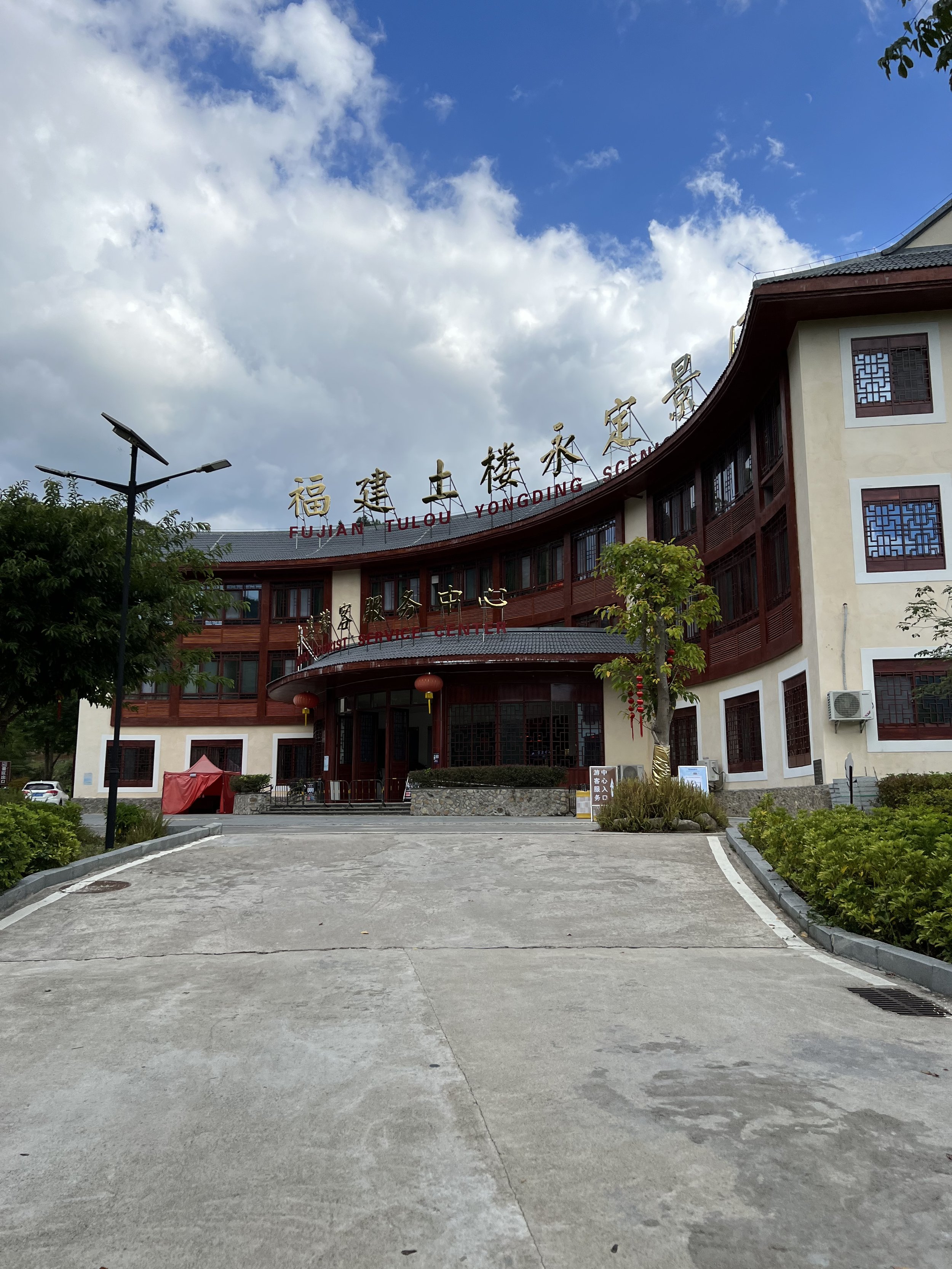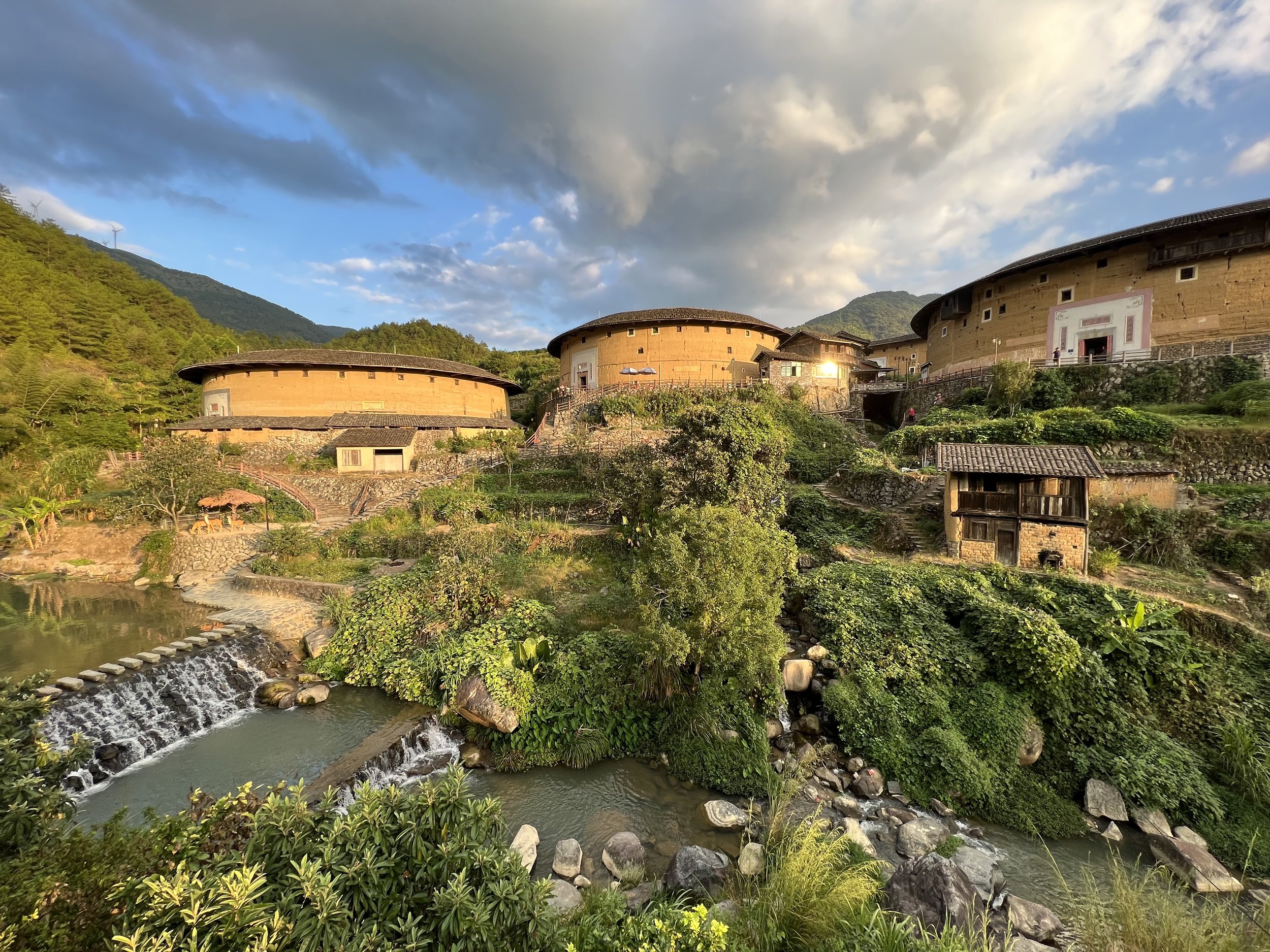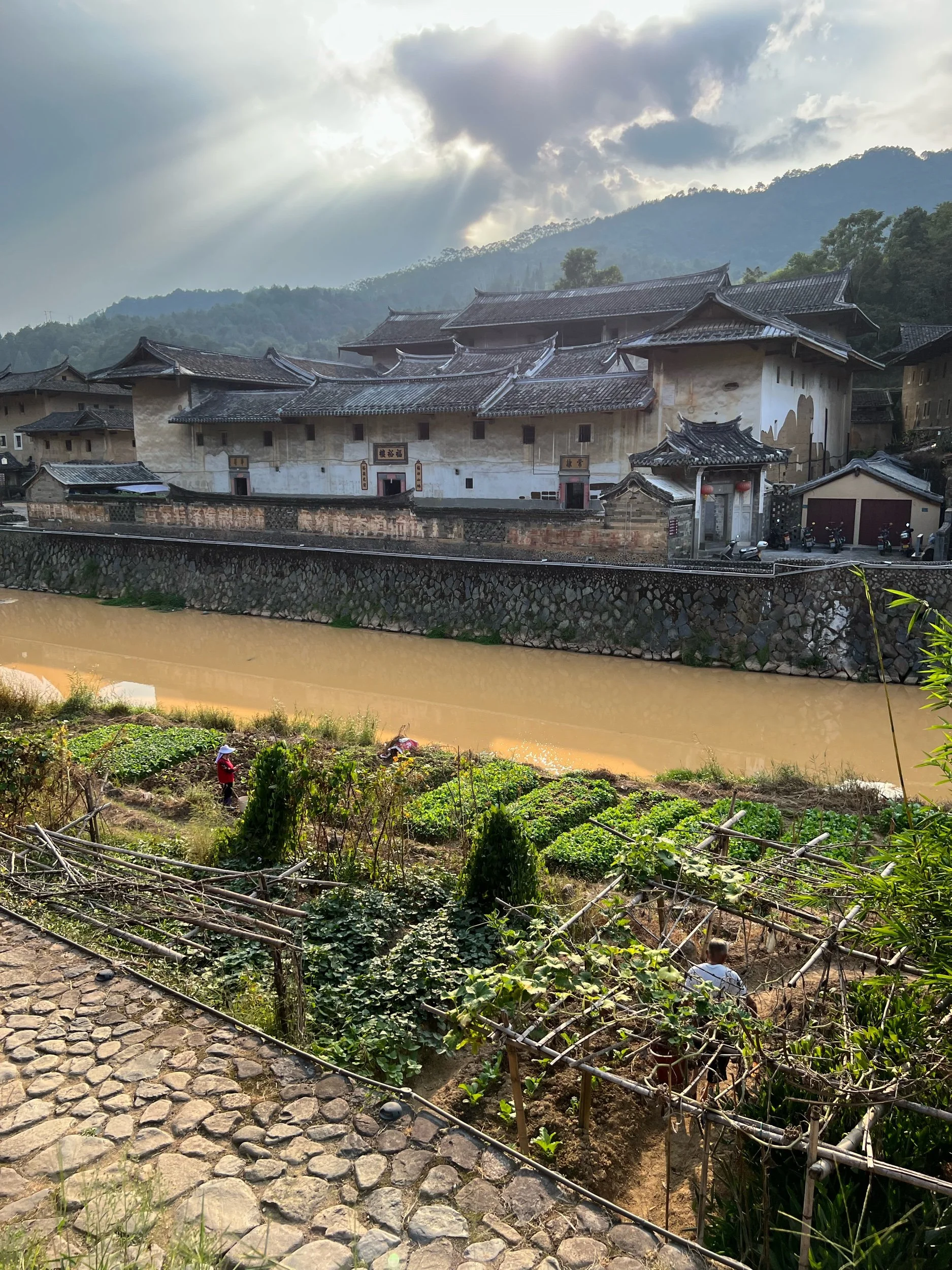Tulou Day 2 afternoon: Finishing up key sites in the Yongding 永定 tulou area
Having just finished seeing the Hekeng tulou cluster (河坑土楼) in the Nanjing (南靖) tulou area, it was just a short drive over to the Gaobei tulou cluster (高北土楼) back in the Yongding (永定) tulou area. It was already past 12:30pm when I finished hiking down from the viewpoint at Hekeng village, and I asked the driver if we should eat in Hekeng, or continue on to Gaobei for lunch. He said we should go on to Gaobei, because there were more options.
Indeed, while Hekeng was a quiet village with just a couple other tourists (I really liked the feeling here), Gaobei was built up with lots of modern buildings, and a huge parking lot for big tour buses. The driver chose the restaurant that seemed to have the most people, directly across from the entrance to the tulou.
“King of Tulou Restaurant” 土楼王饭店 is so named because the key attraction in the Gaobei cluster is the massive “King of Tulou.”
I figure in these parts most locals eat at home, while the restaurants are all for tourists. So I wasn’t picky about where we went; just as long as I could try some interesting dishes.
The first dish to come out was the Hakka tofu (客家豆腐), which was… okay? Slightly fried on the outside, while overall very tender.
The waiter recommended the beef balls. The driver suggested to have them in soup, but the waiter said it was more tasty (比较香) stir-fried. Here they are, glistening in oil. They were very tasty indeed! Perhaps on the salty side, and definitely oily.
We waited the longest for the last dish. The driver was going to cancel the order, but I’m glad it still came out. This was pork stir-fried with dried bamboo shoots (笋干炒肉 I think). The dried bamboo shoots had a pleasing chewy quality!
Gaobei tulou cluster is feels very commercial. Besides the huge parking lot that accommodates large tour buses, it also has this big building which contains the hall where you buy tickets.
Then after your ticket is checked, you walk up stairs, and then through this commercial street lined with shops. There weren’t many open shops, though.
The first tulou after the commercial street is the Qiaofu building (侨福楼), so named for a family that studied abroad (“qiao” 侨 referring to overseas Chinese).
It looked very spruced up inside!
Right next to it is the “King of Tulou,” which is really the Chengqi building 承启楼. It is said to have about 400 rooms in total inside.
What’s cool is that there are three right within the outer ring, with the rectangular ancestral hall at the center.
About this picture below: it’s taken by a camera I think mounted on the third floor. It cost 20 rmb, and I think a lot of people sprung for this. The picture-taking system is quite the ecosystem. First, some ayi touts on the ground floor sell you the service. I tried, bargaining, but they said they only earn 2 rmb per picture, and it seemed everyone paid this price. Then you stand inside the gate and look up at the Chinese flag next to the camera. Then while you’re waiting for the picture to be printed (because this picture is printed and laminated!), the ayi direct you to one of the rooms to have tea, where someone else gives you samples of tea and tries to encourage you to buy some. There’s only one photographer but many ayis and I think many different tea places.
The outer ring has four stories, with 72 rooms on each story. I’m reading on Wikipedia now that the ground floor is usually a kitchen, the 2nd floor is grain storage, and then the 3rd and 4th floors are living areas and bedrooms. Each family is organized in a vertical stack, but there are only four communal staircases. So to go upstairs, one has to to all the way around the ring to the common staircase, then all the way back!
Apparently there was a communal library in the third ring?
Now there are a ton of little stores selling tea and other souvenirs. You can observe the wedge-shaped nature of each room by observing the vertical lines in the ceiling material!
Here’s the tiniest ring in the middle.
After Gaobei, I made a final push to see Chuxi tulou cluster (初溪土楼). While Gaobei tulou cluster in the Yongding area was a very short drive from Hekeng tulou cluster in the Nanjing area, and Chuxi tulou cluster was also in the Yongding area, it was a much further drive of about 45 minutes.
Here, there was also a big entrance hall.
They sold a ticket on a shuttle for 5 rmb to the village, but I thought it might be a picturesque walk so I decided to walk. I think next time I might pay for the shuttle to save some time.
The Chuxi tulou cluster was really stunning, set within verdant bamboo-covered hills and behind this river. It just felt so idyllic, especially in this late afternoon sun.
The first building I entered was Yuqing building 余庆楼.
Here, I was the only tourist. A lady saw me and immediately offered some liangfen 凉粉 jelly which she said she just made.
She opened up a fridge and scooped some up in a full pot of jelly. It was a very hot day, and I was quite thirsty, so this seemed very refreshing!
It was very much worth 3 rmb (US$0.42)!
At this time, a few other tourists came in. She also peddled her liangfen to them, pointing at me saying, even the foreigner is having it! She actually offered them an option of honey as the sweetener for 2 rmb more.
She offered us tea, and also taste tests of the other candies and dried fruit she was selling. The other tourists turned out to be from Meizhou (梅州), my next stop! It was a mother, her daughter, and another girl. The girls tried to practice their English with me; one was quite good, but the other was rather unintelligible. Uh oh! They welcomed me to visit Meizhou. Even though I was kind of on a schedule today (wanted to make it back to the inn for a cooking demonstration!), it felt nice to still make time to sit and rest, and chat.
The others first left, and then the lady said I could go upstairs if I wanted, as long as I didn’t enter any rooms. This was quite nice! Tourists usually aren’t allowed to go upstairs.
Here’s a view of the Yuqing building.
Next door was the Gengqing building (庚庆楼).
This wasn’t particularly remarkable. There was a building with a huge LED display though (on the right).
The main attraction in the Chuxi tulou cluster ifs the Jiqing building (集庆楼). It’s the oldest round tulou in Yongding, 580 years old. No one lives here anymore, since it’s been turned into a museum (but I didn’t really look at any of the displays).
The main feature here are that there are lots of stairs inside - 72 of them!
So remember how families have rooms that are vertically stacked, but there are normally only 2 or 4 communal staircases, making it quite inconvenient to go upstairs? Here families have staircases just outside of their rooms! It is rather remarkable how the “look” of the tulou changes so much with this added convenience.
After seeing the Jiqing building, I hiked up to an viewpoint to see the Chuxi village. It was so beautiful in this light!
After this, I walked back with the driver to the car, and headed back to the inn.







